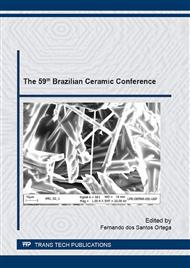p.41
p.46
p.52
p.58
p.64
p.71
p.77
p.83
p.91
Obtaining and Characterization of Porous Bodies Obtained by Gelatinization
Abstract:
Porous ceramics have certain unique properties such as high toughness and resistance to heating at elevated temperatures. These properties make them products of great interest for applications on the field of filters and biomaterials. This paper proposes a new technique, called gelatinization, for processing this class of ceramics in order to obtain materials with more controlled pore size, plus a more homogeneous distribution. In order to check the efficiency of this technique, it was used as a raw material powders of calcined alumina and titania, previously characterized, mixed with unflavored gelatin, water and dispersant for holding the ceramic conformation. Three different formulations (with 40, 50 and 55% of solids content) were investigated using alumina and titania separately. The results indicated that the most suitable composition in terms of moldability was 55% of solids. It was also observed that the use of this technique to obtain bodies of high porosity is feasible; however, more detailed studies of sintering are necessary to obtain parts after firing in a close future. Due to the high porosity obtained the green, a detailed study of the sintering conditions is crucial to obtain parts with physical integrity.
Info:
Periodical:
Pages:
64-68
Citation:
Online since:
November 2016
Keywords:
Price:
Сopyright:
© 2017 Trans Tech Publications Ltd. All Rights Reserved
Share:
Citation:


